“We are too busy building the solution to bother the customer to identify, validate, value and prioritize their requirements.” – Name not disclosed to protect the ignorant
I see this habit all the time with experienced people; the tendency to jump right into solution mode when dealing with customers. Many of these experienced “experts” have seen the “problem” so many times before, that they just “know” the right solution. Heck, sometimes these “experts” even cut off or interrupt the customer’s explanation of the problem because they already know how the story is going to end.
This tendency to jump right into solution mode has the following undesirable effects:
- Customers feel like their situation is not appreciated even if it is the same problem the “expert” has seen a hundred times before.
- Because the customer is being “talked to” and not “listened to”, they feel like they are being “sold to” versus allowing them the opportunity to consider a solution to their problem.
- But maybe more importantly, when we stop listening, we stop learning. Every customer situation is different – even if just slightly – and every customer situation provides a new learning opportunity.
These effects demonstrate what’s known as ‘inside-out’ thinking: seeing the world from our own perspectives, rather than trying to enable a customer’s needs and understand their view of us, which is from the ‘outside-in.’
So how do we overcome this natural tendency to jump right into solution mode? I’ll tell you. It’s Design Thinking to the rescue!
Design Thinking: The Pause that Resets Your Perspective
Design Thinking is about building a deep empathy for or an understanding of the people for whom we are servicing. This means opening our minds to empathize with their situation, validating that we understand their pains and gains, generating tons of ideas; building a bunch of prototypes; sharing what you’ve created with your targeted users; and eventually putting the idea out into the cruel world. Design thinking is all about seeing the world from the ‘outside-in.’
As I have written in the past, the Stanford Design School (or d.school) is world famous for their work and training in the area of Design Thinking. And they (along with John Morley) have made a Design Thinking convert of me (see Figure 1).
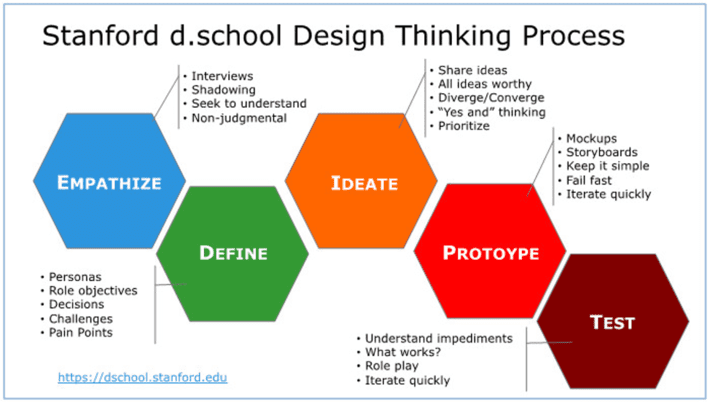
Design thinking forces me to take the time to really understand – and emphasize – with my customers’ situations. Design Thinking forces me to pause, contemplate and double-check that I am providing solutions that my customer actually wants and will use.
In particular, there are three Design Thinking tools that I find most useful.
Template #1: Customer Profile. The Customer Profile template forces you to take the time to really contemplate your target customers’ situation (and you’ll want to create a Customer Profile for customer or stakeholder type), the jobs that they are trying to do, and the gains (benefits) and pains (impediments) associated with those jobs that they are trying to do (see Figure 2).
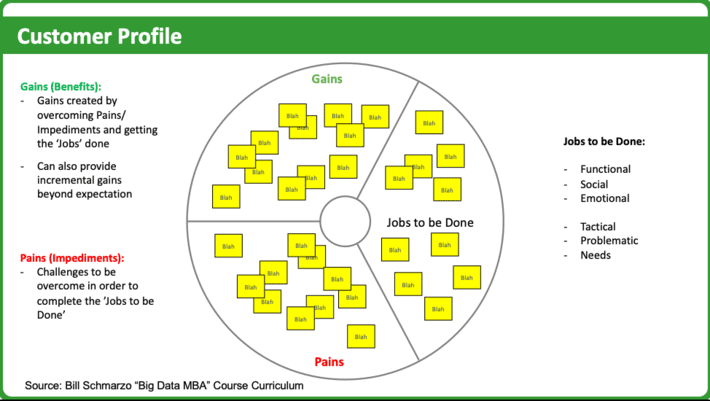
This template can facilitate identifying, validating, valuing and prioritizing the jobs that our target stakeholder needs to do (because not all jobs-to-be-done are of equal value, and some jobs-to-be-done are pre-requisites for other jobs-to-be-done). See the blog “Digital Transformation Law #6: It’s About Monetizing the Pain” for ideas how to not just minimize or avoid pains, but actually contemplate how one might actually monetize the pains that come out of this exercise. The work on the Customer Profile sets up the next template, Customer Journey Map.
Template #2: Customer Journey Map. I love the Customer Journey Map as it forces me to envision the jobs-to-be-done and the associated gains and pains along a holistic customer journey such as buying a house, planning a vacation or repairing a broken compressor (see Figure 3).
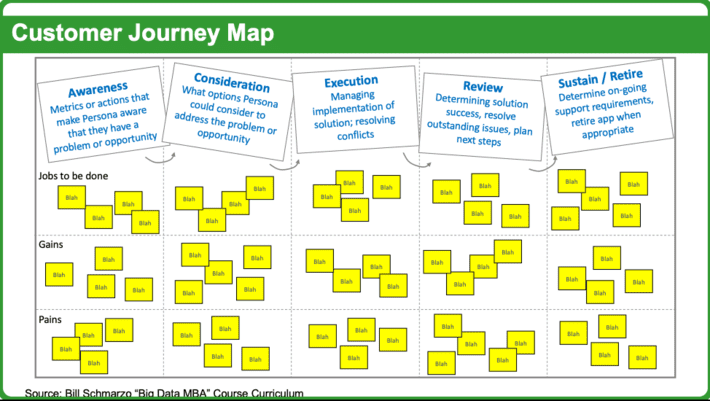
The Customer Journey Map forces you to walk in your customers’ shoes through:
- Identifying and understanding the situation, and any associated metrics, that has made the targeted stakeholder aware that they have a problem or opportunity.
- The options the targeted stakeholder could consider in order to address or solve the problem or opportunity.
- The process of managing the implementation of the solution and resolving any conflicts and/or changes that arise during the implementation of the solution.
- Ascertaining solution implementation success, identifying and resolving outstanding issues, and planning next steps or enhancements.
- Sustain / Retire. Determining on-going support requirements to sustain the solution and ending or retiring the journey when appropriate.
Template #3: Customer Value Map. Finally, the Customer Value Map then summarizes everything from the Journey Map into a customer solution that takes into full consideration the key actions or decisions and the associated gains and the pains (see Figure 4).
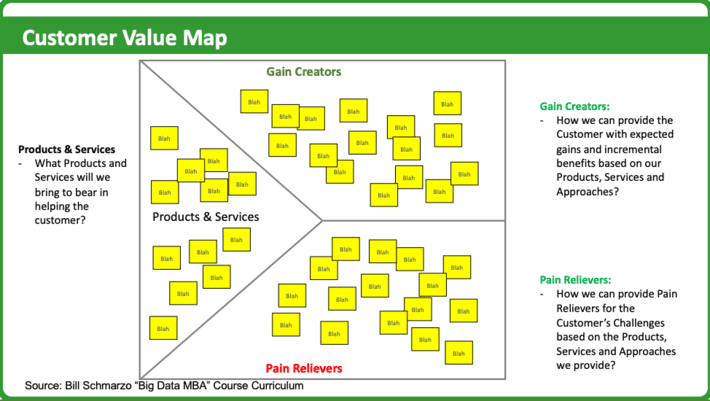
The Customer Value Map captures the following solution requirements:
- What Products and Services will we bring to bear in helping to address the customer’s situation or challenge?
- How we can provide the Customer with expected gains and incremental benefits based on our Products, Services and Approaches?
- How we can provide Pain Relievers for the Customer’s Challenges based on the Products, Services and Approaches we provide?
Design Thinking Leads to Data Science Success
These Design Thinking templates ensure that you are properly prepared to deliver a meaningful and successful solution in the eyes of your customer. We convert these Design Thinking templates into two important Data Science documents. Document #1 is the Customer Challenge Canvas (see Figure 5).
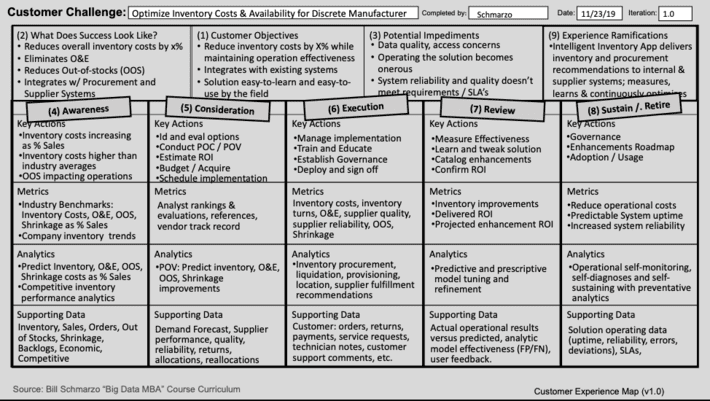
Figure 5 shows the Customer Challenge Canvas for a Discrete Manufacturer who is trying to optimize inventory costs & availability. The Customer Challenge Canvas decomposes each stage of the customer journey into key actions (or decisions), metrics against which progress and success will be measured, the different analytics that we will need to provide to support the journey, and what data might be useful in supporting the analytics.
The Customer Challenge Canvas also captures the following framing information prior to diving into decomposing the customer journey:
- Customer business and operational objectives, or why is this challenge important to the customer from a business or operational perspective.
- “What Does Success Look Like” panel which forces the customer to explain their desired or expected business outcomes.
- Potential Impediments which highlights some of the key obstacles to successful development and deployment.
- Experience Ramifications that outlines how the results of the work will be materialized or presented to the key operational and business stakeholders.
Then the work from the Customer Challenge Canvas is summarized into our Hypothesis Development Canvas, which I have written about extensively (see Figure 6).
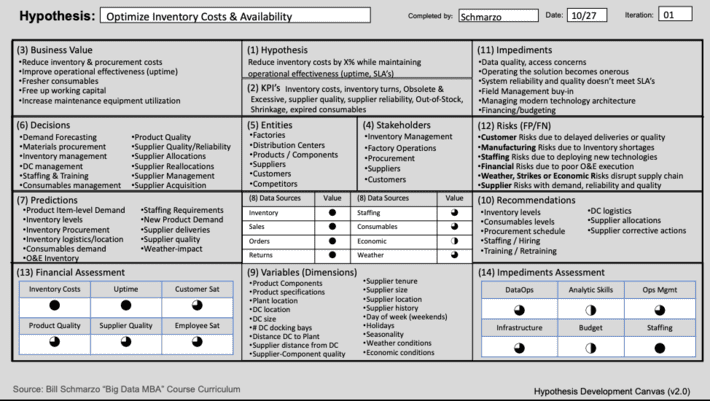
Summary: Jumping into Solution Mode
Taking the time to understand and empathize with your targeted stakeholders is critical, but to many “experts” it just seems to delay getting to the solution (and getting paid). It’s just easier to start developing a product or solution based upon one’s superior knowledge of the problem than to be forced to contemplate the business and operational needs that just might be unique for that customer.
At Hitachi Vantara, we developed the Digital Value Enablement (DVE) methodology to help us counter this natural tendency to jump right into solution mode. The DVE is really a manifestation of the Data Science Value Engineering process upon which I talk, write and teach frequently; a process that ensures that we have thoroughly listened to our customers’ business and operational requirements before we ever “put science to the data.”
Design Thinking techniques can seem counter-intuitive at the start but give yourself the patience to stick with it! Acknowledge this natural tendency to jump right into solution mode and embrace a Design Thinking mindset and techniques to listen, grow and learn before springing into solution mode.
Design Thinking provides the mindset and techniques to force one to understand what success looks like from their customers’ / stakeholders’ perspectives; to identify the metrics against which progress and success of the jobs-to-be-done will be measured and promotes the gains while avoiding or minimizing the pains.
We all tend to jump right into solution mode (especially as we get older and less patient) because we have seen the “problem” so many times before. This behavior ends up alienating customers because we’re not really willing to listen to them and denies us learning opportunities because every customer’s problem is different, even if only seen from their own eyes.
Heck, I’m just as guilty of jumping too quickly into solution mode. Just ask my wife…
